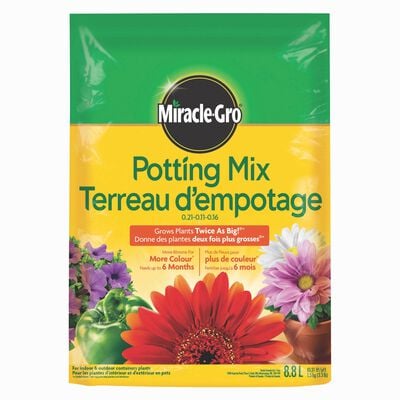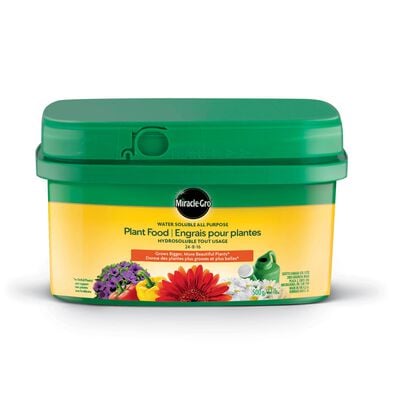
Plant Food Basics
Just like people, plants need to eat in order to thrive. Regularly feeding your plants ensures they grow properly, produce beautiful blooms and fruit, and build resilience to harsh weather conditions and disease. Native soil often lacks enough nutrition for plants to reach their full potential, so it's important to improve it by adding new soil and fertilizer.
Starting with nutrient-rich bagged soil is a great way to give plants a jump start to the growing season. For containers and raised beds, you can start fresh with all new soil by using Miracle-Gro® Potting Mix (for containers). If you have an in-ground garden bed, then till 3 inches of Miracle-Gro® All Purpose Garden Soil into the top 6 inches of your existing soil.
Eventually, the nutrients in the soil are used up and need to be replenished. And many plants (especially heavy feeders like tomatoes and dahlias) need more food as the season wears on. That's why it's important to regularly fertilize throughout the growing season.
It's All About the Nutrients: NPK
Plant food delivers three main nutrients to plants:
- Nitrogen (N)-helps fuel growth.
- Phosphorus (P)-promotes root development, increases blooms, and helps gets plants off to a strong start.
- Potassium (K)-essential to overall plant health; helps plants fight off diseases and withstand stressful growing conditions (like drought and heat).
These three key nutrients appear somewhere on every plant food package as a series of numbers, such as the 12-4-8 found on Miracle-Gro® Shake 'N Feed® All Purpose Plant Food. The first number, 12, refers to the percentage, by weight, of nitrogen (N) in the plant food. The second number, 4, refers to the percentage of phosphorus (P), and the last number, 8, refers to the percentage of potassium (K).
Plants also benefit from other nutrients, such as calcium and magnesium, which are included in many plant foods. If you look on the back of any fertilizer package, you'll see a list of all the nutrients it contains.
Types of Plant Food
Plant food typically comes in three different forms:
- Continuous release granules
- Liquids
- Water soluble powders or crystals
Continuous release plant foods, such as Miracle-Gro® Shake 'N Feed® All Purpose Plant Food, usually comes in granular form, and the nutrients are released slowly over time. Mix this type of fertilizer directly into the soil surrounding the plant. To find out how much and how often to feed, it's always best to refer to the product label.
With liquid and water soluble fertilizers, the feeding happens when you water. Miracle-Gro® Water Soluble All Purpose Plant Food, for example, can either be mixed in a watering can or delivered through your garden hose with the Miracle-Gro® Garden Feeder attachment. The hose attachment mixes the plant food for you, so all you have to do is water as you normally would. These kinds of plant foods need to be applied more often than continuous release fertilizer, but the nutrients reach plants more quickly.
How to Feed Your Plants
If you've ever been reluctant to fertilize your plants because it's unclear or complicated, then we're here to help all of that go away. Here's how to start feeding your plants in 3 easy steps.
- Choose a plant food. Continuous release fertilizers are great if you prefer a slightly hands-off approach, but if you're out in the garden on a weekly basis, then liquid or water soluble plant foods could be a better option.
- Start feeding early. To get the best results, begin feeding your plants in early spring so they have the nutrients they need to start the growing season off strong. Continue to feed on a regular basis according to label directions.
- If you've planted new plants in Miracle-Gro® soil or potting mix, then wait 30 days to start fertilizing because your plants will feed off the abundant nutrients already in the soil.
- Set reminders. Remembering to feed your plants can sometimes be the hardest part. If you're using a water soluble or liquid plant food, then you'll have to feed every 7-14 days, depending on which product you have.
- Continuous release fertilizers are applied less often, usually around every 6 weeks. Always refer to the product label for how often to apply. Once you know the right feeding schedule, set a recurring reminder in your phone or smart speaker to help keep you on track.
Should You Feed Your Plants in Summer?
Absolutely! While some folks believe that you shouldn't fertilize the garden in summertime, the opposite is actually true. After all, that's when plants are growing most vigorously—think of them as ravenous teenagers. That doesn't mean you should give them more food than the label says (that's never a good idea), but it does mean that you'll want to stick with a regular feeding schedule to make sure your plants are getting enough to eat.
No matter what kind of plant food you choose or what time of year you're feeding, be sure to follow the directions on the label for the best results. Do that and your plants will never go hungry!




